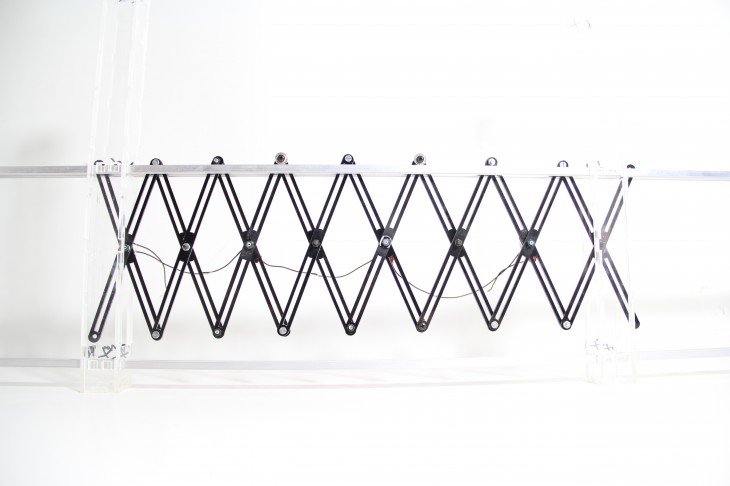 The use of bi-metals in architecture is relatively new and has always been used as the metallic sheet itself. This is a new approach to the already existing technology and know how. The bi-metals work in a similar manner to thermostatic materials. The approach was to use bi-metals in architecture in order to convert a temperature change (input) into mechanical displacement (output).
The use of bi-metals in architecture is relatively new and has always been used as the metallic sheet itself. This is a new approach to the already existing technology and know how. The bi-metals work in a similar manner to thermostatic materials. The approach was to use bi-metals in architecture in order to convert a temperature change (input) into mechanical displacement (output).  The use of the coil shaped bi-metal provides enough mechanical displacement to move much larger objects. On heating the bi-metal helps move the members which then return to their original location on being cooled. The product has the potential to grow as an industrial product based on the availability and manufacturing of the bi-metals of the appropriate scale. The expansion and contraction of the bi-metals could be used for numerous purposes such as roofing devices or shading devices and also facade treatments. The goal is to enhance the advantage the bi-metal posses and use it to create motion that would ease our daily life. The future uses could be temporary structures or deployable structures. After a study of the bimetals as shown in phase 1 (
The use of the coil shaped bi-metal provides enough mechanical displacement to move much larger objects. On heating the bi-metal helps move the members which then return to their original location on being cooled. The product has the potential to grow as an industrial product based on the availability and manufacturing of the bi-metals of the appropriate scale. The expansion and contraction of the bi-metals could be used for numerous purposes such as roofing devices or shading devices and also facade treatments. The goal is to enhance the advantage the bi-metal posses and use it to create motion that would ease our daily life. The future uses could be temporary structures or deployable structures. After a study of the bimetals as shown in phase 1 (
http://legacy.iaacblog.com/maa2013-2014-digital-matter-intelligent-constructions/2014/04/bimetals/)
Other optimum geometries were tested 
 the scissors mechanism was then developed to form a ring that could expand and contract as shown in the video below:
the scissors mechanism was then developed to form a ring that could expand and contract as shown in the video below:
This system was not a success since the force required to lift the structure against gravity was not equivalent to what the bi metal was able to provide. Thus from this we developed a system of linear mechanism that would work in a similar manner using tracks in order to negate the gravitational force.  Various materials and an understanding of how they function were then tried.
Various materials and an understanding of how they function were then tried.  The finally offered proposal was that of a façade system
The finally offered proposal was that of a façade system 
 The idea in this case was more to provide a system and mechanism which could be adapted to any context like in terms of structure members, roofs etc. The project is not a conclusion but an ongoing development that can evolve to be used with membranes, fabrics and also a Fresnel lens that would help concentrate the heat for it to perform better in a a passive manner. The study aims to show the magnified effect that can be created by a much smaller element.
The idea in this case was more to provide a system and mechanism which could be adapted to any context like in terms of structure members, roofs etc. The project is not a conclusion but an ongoing development that can evolve to be used with membranes, fabrics and also a Fresnel lens that would help concentrate the heat for it to perform better in a a passive manner. The study aims to show the magnified effect that can be created by a much smaller element.  The making of the prototype and its functioning can be viewed in the link below :
The making of the prototype and its functioning can be viewed in the link below :
